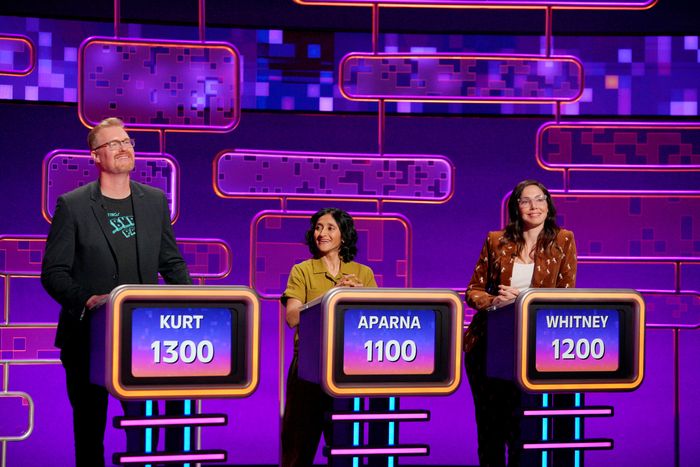
Comedy Central’s comedy game show @midnight became a fossil the second it went off the air in 2017. This happens to all late-night shows to an extent, but by setting out to chronicle ever-changing internet phenomena, @midnight all but guaranteed its segments referencing platforms like Yahoo Answers and Vine would age poorly. So when CBS announced that a revival of the show hosted by Taylor Tomlinson would be taking the time slot formerly occupied by The Late Late Show With James Corden, it sparked immediate questions. How would it update the format for a modern internet landscape where Twitter is half-dead, social-media consumption is more fragmented than ever, and late-night clips are expected to drive online conversations rather than just respond to them?
After Midnight finally premiered on January 16 after a series of strike-related delays, and the early returns suggest it may not be that different from the original. There remains a panel of three comedians — the premiere features Kurt Braunohler, Whitney Cummings, and Aparna Nancherla — and they still compete in a series of internet-themed games, a mix of new segments and mainstays from the original like the interactive Hashtag Wars and FTW at the end of each episode. The show is now an hour long as opposed to a half an hour, and Tomlinson mercifully doesn’t say “Points!” every time a comedian chimes in with a joke (though this tradition is carried on, apparently, in the show’s Instagram comments). But the format is largely the same. If CBS is planning to swap out the panel of comedians for massive movie and TV stars with high-profile projects to promote, they haven’t done so yet.
Standing beside a giant screen designed to look like a phone, Tomlinson opens the premiere by explaining the show’s intention (“taking the internet and desperately trying to make it fun”) and introducing the audience to her comedic sensibility: “Comedians, you’ll be competing for the grand prize of my father’s approval. It is rare but winnable!” She uses an early segment about the previous night’s Emmy Awards to joke about the show’s format in more detail. “I don’t even know what awards our show can possibly win,” she begins. “It’s kind of a talk show where there’s no conversation. It’s a game show, but the points are fake. It’s a vanity project, but it somehow makes me look worse.” Braunohler is quick to buzz in with a response for an awards category After Midnight would dominate: “Best Female Late-Night Host. Sorry, Only Female Late-Night Host.”
Predictably, After Midnight’s new games are a mixed bag, signaling a show still tinkering with its formula. Group Chat, a segment designed to prompt jokes about current viral phenomena, feels like it’ll be a utilitarian fixture; Tik Chopped, in which contestants are shown videos of TikTok chefs preparing off-putting food using disgusting methods, inspires some good jokes but ignores the fact that many of these videos are explicit outrage bait; What I Can’t Live Without, in which comedians weigh in on influencer-pushed products, seems like an endlessly refillable concept; Suburban Dictionary is a flimsy excuse to get laughs from older millennials using Gen-Z slang, rarely an inspired comedic premise.
Perhaps the most fun segment, To Smash or Not to Smash, gives the comedians an opportunity to step away from their podiums to debate and form a consensus about people they’d rather have sex with, like the Quaker Oats mascot or Gritty. Content aside, it works during the premiere because it is comparatively looser and allows the comedians more room to bounce off one another. Similarly, a Jeopardy!-inspired segment after the first commercial break, in which Tomlinson asks each of the guests one interview question, offers a promising change of pace. “We’re working on the talk-show part,” Tomlinson jokes of the segment.
After the episode finished airing, Variety reported that the premiere had been kept intentionally “lowkey” to give the show a chance to “find its voice over the next few weeks” (before the Super Bowl and the return of CBS’s scripted series in February presumably bring in more viewers). After Midnight has been soft-launched on social media thus far: The show has bypassed Twitter entirely, only one clip (the episode’s Hashtag Wars segment) has been posted to Instagram and TikTok, and the debut episode can only be viewed on YouTube in full. For its first little while on the air, After Midnight will be a breathing, ever-changing product, not unlike the internet itself.


